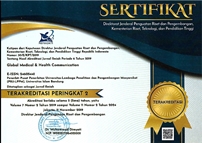The Role of Lumbar CT Scan Anthropometric Parameters to Predict the Height of Indonesian Adults
Abstract
Anthropometry, the study of human body measurements, is crucial in estimating stature, which is valuable in medical research, forensic science, anthropology, and ergonomic design. While various methods exist for estimating stature, lumbar spine measurements make a significant contribution to this estimation. This study aimed to analyze the relationship between lumbar spine dimensions and stature in the Indonesian population using three-dimensional computed tomography (3D CT) scan data. This analytical observational study, employing a cross-sectional approach, was conducted at the Department of Radiology, Dr. Soetomo General Academic Hospital, Surabaya, from August to September 2023. The key measurements included heights of the posterior, anterior, and central vertebral bodies from lumbar 1 to lumbar 5 (L1 to L5), transverse pedicle diameter, pedicle axis length, vertical pedicle diameter, and overall stature. The study included 66 subjects (30 males and 36 females). Males had an average height of 165.86 cm, while females had an average height of 155.85 cm. Significant gender differences were observed in heights of the posterior vertebral body (HPVB), heights of the central vertebral body (HCVB), and pedicle axis length (PAL) measurements. HPVB of L1 can be used as a predictor of height in females (p<0.001), whereas PAL of L5 can be used as a predictor of height in males (p=0.006). Lumbar spine dimensions measured using 3D CT scans provide reliable stature predictions, with specific measurements such as HPVB from L1 in females and PAL from L5 in males showing high accuracy. These findings support the development of population-specific anthropometric tools and enhance understanding of factors influencing stature in Indonesia.
Keywords
Full Text:
PDFReferences
Utkualp N, Ercan I. Anthropometric measurements usage in medical sciences. Biomed Res Int. 2015;2015:404261.
Louer AL, Simon DN, Switkowski KM, Rifas-Shiman SL, Gillman MW, Oken E. Assessment of child anthropometry in a large epidemiologic study. J Vis Exp. 2017;(120):54895.
Klein A, Nagel K, Gührs J, Poodendaen C, Püschel K, Morlock MM, et al. On the relationship between stature and anthropometric measurements of lumbar vertebrae. Sci Justice. 2015;55(6):383–7.
Zhang K, Chang YF, Fan F, Deng ZH. Estimation of stature from radiologic anthropometry of the lumbar vertebral dimensions in Chinese. Leg Med (Tokyo). 2015;17(6):483–8.
Dianat I, Molenbroek J, Castellucci HI. A review of the methodology and applications of anthropometry in ergonomics and product design. Ergonomics. 2018;61(12):1696–720.
Oura P, Korpinen N, Niinimäki J, Karppinen J, Niskanen M, Junno JA. Estimation of stature from dimensions of the fourth lumbar vertebra in contemporary middle-aged Finns. Forensic Sci Int. 2018;292:71–7.
Frizziero A, Pellizzon G, Vittadini F, Bigliardi D, Costantino C. Efficacy of core stability in non-specific chronic low back pain. J Funct Morphol Kinesiol. 2021;6(2):37.
Choong CL, Alias A, Abas R, Wu YS, Shin JY, Gan QF, et al. Application of anthropometric measurements analysis for stature in human vertebral column: a systematic review. Forensic Imaging. 2020;20:200360.
Decker SJ, Ford JM. Forensic personal identification utilizing part-to-part comparison of CT-derived 3D lumbar models. Forensic Sci Int. 2019;294:21–6.
Kranioti EF, Bonicelli A, García-Donas JG. Bone-mineral density: clinical significance, methods of quantification and forensic applications. Res Rep Forensic Med Sci. 2019;9:9–21.
Ruriana I, Setiawati R, Prijambodo D. Sex identification using adult pelvic 3D CT scan: an anthropometric study. IJRP. 2020;64(1):143–8.
Setiawati R, Rahardjo P, Ruriana I, Guglielmi G. Anthropometric study using three-dimensional pelvic CT scan in sex determination among adult Indonesian population. Forensic Sci Med Pathol. 2023;19(1):24–33.
Güleç A, Kaçıra BK, Kütahya H, Özbiner H, Öztürk M, Solbaş ÇS, et al. Morphometric analysis of the lumbar vertebrae in the Turkish population using three-dimensional computed tomography: correlation with sex, age, and height. Folia Morphol (Warsz). 2017;76(3):433–9.
Khaleghi M, Memarian A, Shekarchi B, Bagheri H, Maleki N, Safari N. Second and third lumbar vertebral parameters for prediction of sex, height, and age in the Iranian population. Forensic Sci Med Pathol. 2022;19(3):364–71.
Diacinti D, Pisani D, Del Fiacco R, Francucci CM, Fiore CE, Frediani B, et al. Vertebral morphometry by x-ray absorptiometry: which reference data for vertebral heights? Bone. 2011;49(3):526–36.
Yu CC, Yuh RT, Bajwa NS, Toy JO, Ahn UM, Ahn NU. Pedicle morphometry of lumbar vertebrae: male, taller, and heavier specimens have bigger pedicles. Spine (Phila Pa 1976). 2015;40(21):1639–46.
Spradley MK. Metric methods for the biological profile in forensic anthropology: sex, ancestry, and stature. Acad Forensic Pathol. 2016;6(3):391–9.
Liebl H, Schinz D, Sekuboyina A, Malagutti L, Löffler MT, Bayat A, et al. A computed tomography vertebral segmentation dataset with anatomical variations and multi-vendor scanner data. Sci Data. 2021;8(1):284.
Ning L, Song LJ, Fan SW, Zhao X, Chen YL, Li ZZ, et al. Vertebral heights and ratios are not only race-specific, but also gender- and region-specific: establishment of reference values for mainland Chinese. Arc Osteoporos. 2017;12(1):88.
Courtois EC, Ohnmeiss DD, Guyer RD. Assessing lumbar vertebral bone quality: a methodological evaluation of CT and MRI as alternatives to traditional DEXA. Eur Spine J. 2023;32(9):3176–82.
Pezzuti IL, Kakehasi AM, Filgueiras MT, De Guimarães JA, De Lacerda IAC, Silva IN. Imaging methods for bone mass evaluation during childhood and adolescence: an update. J Pediatr Endocrinol Metab. 2017;30(5):485–97.
DOI: https://doi.org/10.29313/gmhc.v13i1.14225
pISSN 2301-9123 | eISSN 2460-5441
Visitor since 19 October 2016:
Global Medical and Health Communication is licensed under a Creative Commons Attribution-NonCommercial-ShareAlike 4.0 International License.
- https://jurnal.narotama.ac.id/
- https://www.spb.gba.gov.ar/campus/
- https://revistas.unsaac.edu.pe/
- https://proceeding.unmuhjember.ac.id/
- https://ejournal.uki.ac.id/
- https://random.polindra.ac.id/
- https://jurnal.politeknik-kebumen.ac.id/
- https://scholar.ummetro.ac.id/
- https://ejournal.uika-bogor.ac.id/
- https://journals.telkomuniversity.ac.id/
- https://www.iejee.com/
- https://e-journal.iainptk.ac.id/
- https://journal.stitpemalang.ac.id/
- https://revistas.unimagdalena.edu.co/
- https://catalogue.cc-trieves.fr/
- https://revistas.tec.ac.cr/
- https://jurnal.poltekapp.ac.id/
- https://ojs.adzkia.ac.id/
- https://journal.umpalopo.ac.id/
- https://journal.unifa.ac.id/































.png)
_(1).png)
_(1).jpg)
